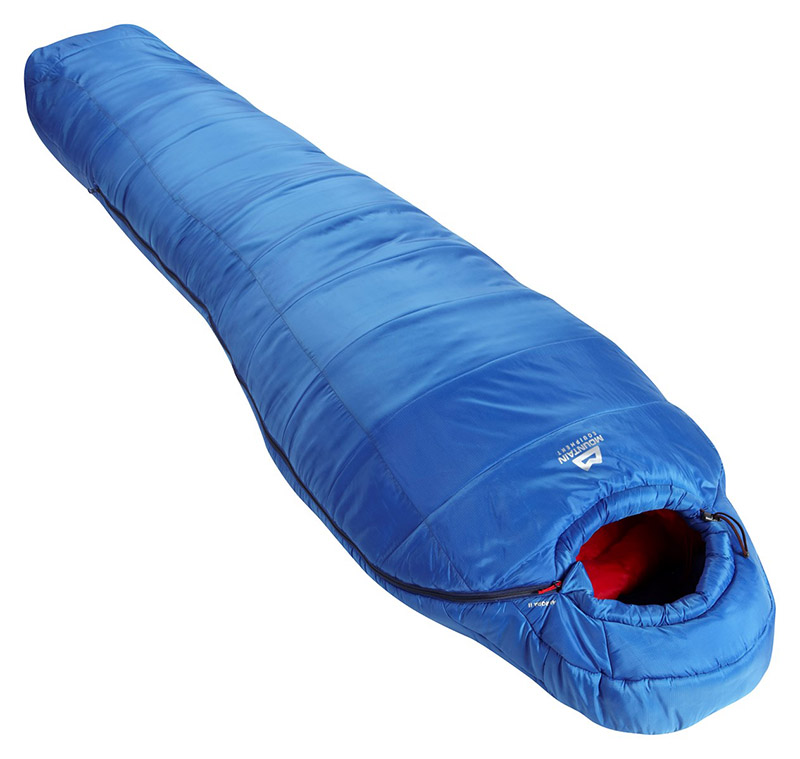Carinthia's Defence 4 Sleeping Bag
Preface
The following assumes the use of a tent / hooped bivvy or a tarp and bivvy in warmer conditions (hammock users will need to decide whether such a system may benefit them).
A great deal of testing in varied conditions has brought us to recommending this "modular system". However, more than perhaps any other item, sleeping bags and their worth seems a very personal matter. Everyone's metabolism is different, some sleep hot, some cold, some on their side, some on their back, some probably sleep upside down ... who knows.
All we can do here is recommend what works for us and in doing so provide some useful information to consider before spending what can be a considerable amount of money and often the largest budget item(s) in any pack.
We also assume some sensible sleepwear and this combination has been tested with the thermal underwear recommended in our "sleepwear section" (we do not assume the wearing of insulated jackets or over-trousers).
The combination of sleeping bags we recommend are intended to work together enabling their user to carry only what is likely to be necessary for each trip. This combination will work from the arid to the tropical and down into frostbite territory. It uses a mix of synthetic and down insulation, with the down bag always on the inside (except in conditions where warm dry weather is predictable and persistent).
This system will not be too relevant to those who venture out only when it's a nice day; but will likely be of interest to those who enjoy the challenge of enduring the unpleasant conditions that hostile environments visit upon them.
Test subject: Chest 42", Waist 33", Height: 5ft 8"
Test item(s): Both 185 and 200 versions
Kit Tests: Winter (multiple)
Disclaimer: None required (item not provided by manufacturer)
Datasheet
| Outer Material: Shellproof [Polyamide (Ripstop Nylon) + PU Coating] | 100% |
| Inner Material: Shelltrans [Polyamide (Nylon)] | 100% |
| Insulation: G-LOFT Duro (Hollofibre Polyester, Inner + Outer) | 290 gsm |
| Dimensions (Medium / 185): Length / Width top / Width bottom | 185 / 84 / 57 cm |
| Dimensions (Long / 200): Length / Width top / Width bottom | 200 / 87 / 60 cm |
| Weight (Medium / 185) w/o stuff sack +209g (7 oz) | ~1,650g (58 oz) |
| Weight (Long / 200) w/o stuff sack +209g (7 oz) | ~1,800g (63 oz) |
| Temperature specifications according to EN 13537 (Comfort Limit / Extreme) | -15 °C (10 ℉) / -36 °C (-33 ℉) |
| Pack size | 25 x 38 cm |
| Manufacturer RRP (priced in Euro = 185.00) | ~ £160.00 |
Scramble Review
Contents
- Materials
- Features
- Temperature Rating
- Weight & Modularity
- Negatives?
- Conclusion & Rating
- Postscript: Notes on Down & Stuff Sacks
Introduction: Food for Fit
I've tested both variants of the Defence 4 and the 185 (M) is a better fit for someone of my height (5ft 8"). However, in very cold conditions where you may want to store your boots (and other damp gear) in a waterproof bag inside your sleeping bag, to prevent them icing up, the extra length provided by the 200 (L) can makes this a little more comfortable. Something worth considering, before buying any sub-zero sleeping bag (and we'll get into this more later in the review). Pictured in this review is my old, 200 version.
Carinthia is an Austrian company that manufactures products for military and civilian markets. The closest analogue in the UK would be a company like Snugpak, but I would argue that Carinthia's products are generally of a higher standard. All of Carinthia's products are made either in Austria or elsewhere in the EU.
The Defence 4 is a high performance, military grade, "mummy" sleeping bag, but I'd say it was more simply tapered than mummy-shaped, with the footbox narrowing to approximately 2/3 the width of the shoulder section. The generous fit is largely due to the fact that the Defence 4 is designed to a) be part of a system (a Modular Sleep System, MSS) and b) to sleep combat ready troops, thus the quick release (non-snagging) central zip. Despite its sizing and fit, the Defence 4 is an impressively warm bag, and for its warmth and robustness, equally impressively lightweight.
Later in this review, we'll provide some background information, to explain why we think the Defence 4 is such a good option (especially for a civilian modular system), but before we do, we'll take a quick tour of the Defence 4.
Materials
The Defence 4's Shellproof outer shell is made from lightweight, durable, ripstop-reinforced, PU coated polyamide (nylon) and is both windproof and to a degree, waterproof (with a hydrostatic head of 1000mm). Yet despite this impressive outer protection, the bag is surprisingly breathable.
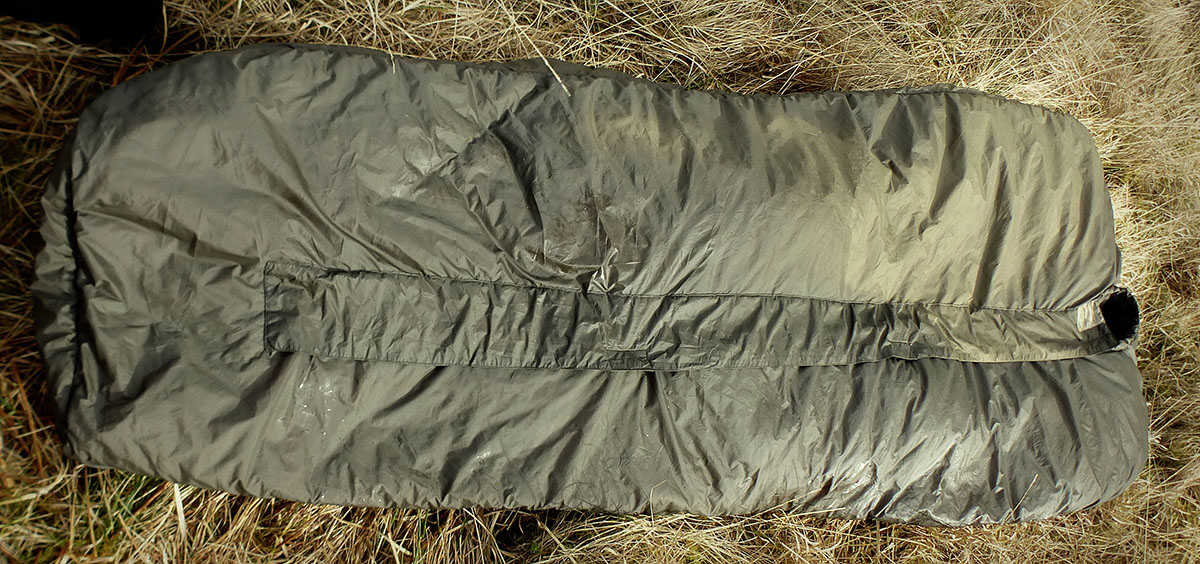 This image is a little misleading due to the angle nullifying the degree of "mummification".
This image is a little misleading due to the angle nullifying the degree of "mummification".
On the inside, the Shelltrans lining consists of a soft ripstop reinforced polyamide which has excellent moisture wicking properties; transporting moisture to the outside of the bag where it evaporates.
In Scramble's 2017 Winter Kit Test the major issue was not so much the cold, but the wet. It rained, hailed or snowed (mainly rained) almost constantly over the 7 days. So, although the temperature only dipped below zero in the evenings and early mornings, it felt a little colder. Sleeping with damp baselayers to get them drier for the morning, the bag's breathablity was put to the test. Clothes dried out and a great deal of condensation formed on the inside of the Bush Cocoon hooped bivvy. So, the sleeping bag did its job - it stayed warm when damp, and moved the moisture outside the bag, the waterproof outer then prevented the condensation getting back in. The Defence 4 is remarkably breathable for such a wind and water-resistant sleeping bag.
 The Carinthia Defence 4 drying out during the 2017 Winter Kit Test
The Carinthia Defence 4 drying out during the 2017 Winter Kit Test
G-Loft is Carinthia's proprietary, "hollowfiber" synthetic fill, manufactured in-house (in Austria). It's very compressible, has an excellent warmth-weight ratio and is also moisture resistant, meaning that it will work even under long term use in damp conditions. G-Loft filling has a memory effect and once released from its stuff sack, lofts quickly.
The G-Loft insulation contains Carinthia's Thermoflect, a very thin, very lightweight aluminium material which reflects body heat. Carinthia state that Thermoflect raises the sleeping bag's heat-retaining capacity by around 11%. Though it's hard to substantiate that claim, what is clear is that even though the bag is very heavy-duty, it's surprisingly light considering its warmth and military-grade features, perhaps this is in part due to the heat retention provided by Thermoflect.
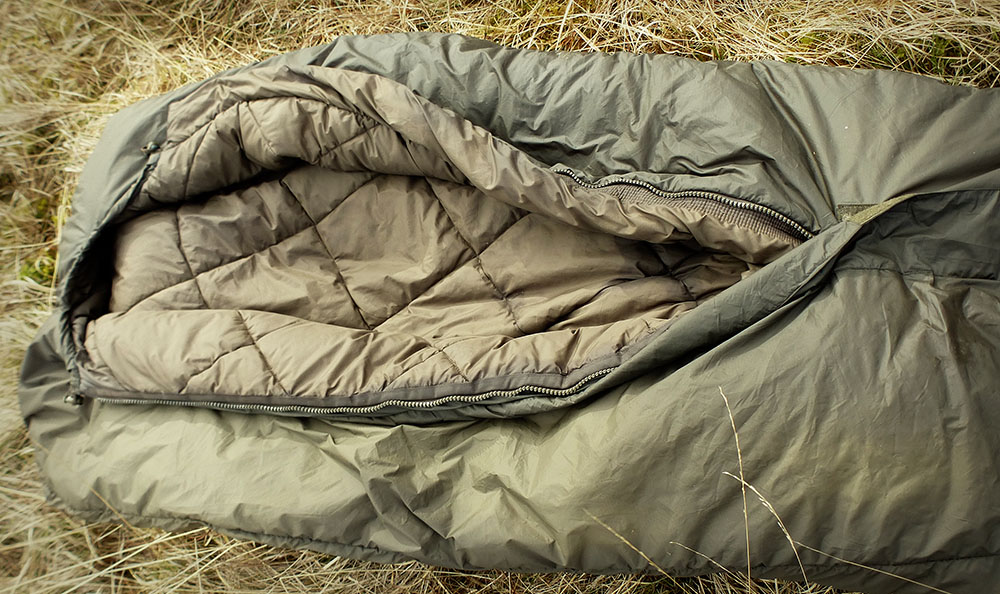 The Carinthia Defence 4's offset quilting avoids cold spots
The Carinthia Defence 4's offset quilting avoids cold spots
The Defence 4 uses double layered G-Loft filling. Two G-LOFT insulation layers are arranged so that the quilting is offset. The outer shell is attached afterwards, this creates a further layer of air between the quilted insulation and the shell. With no stitched perforations in the shell, the Defence 4 is almost water and airtight. This is noticeable when it comes to packing up the Defence 4, and unless care is taken, trapped air balloons the outer, making stuffing a hassle. I always fully unzip the bag, open it up, and then stuff the foot-box first. This allows air to escape while you're packing it. This procedure is more necessary if you're not using the Carinthia compression sack. I always carry the Defence 4 on the outside of my pack, in an Ortlieb 22L PD350 Dry Bag.
Features
The Hood
More than anything a sleeping bag is defined by its materials and fabrication. However there are some features worthy of note. The most noticeable (when compared to a traditional sleeping bag) is the hood and its small, cinched opening.
 A sleeping bag's impression of Edward Munch's "The Scream"
A sleeping bag's impression of Edward Munch's "The Scream"
The Carinthia Defence 4 has what on first inspection appears to be a claustrophobically small opening for one's face. But in use (after a few nights of getting used to it) it works really well. In very cold conditions, I sleep in a light, merino balaclava, this combined with the small cinch-able face hole, leaves very little exposed to the cold. It also helps keep warm air inside the bag, and the hood likely mitigates the need for a neck baffle (which is not missed). The hood is large enough to fit a light insulated jacket inside it for a pillow.
I often fall asleep on my back and wake up on my side, and would say I'm predominantly a side sleeper. The Defence 4 works equally well for both. You can toss and turn from side to side and the bag will turn with you without much trouble.
The Zips
The Defence 4 features a double zipper, so it can be unzipped from the bottom for ventilation when required. The top zip can be opened from the inside as well as outside (the bottom zip is outside only). Stitched to the side of the zip is a ribbon guide, which prevents it from snagging. The Defence 4 is the most non-snagging bag I've ever used - a superb (non-YKK) zip design.
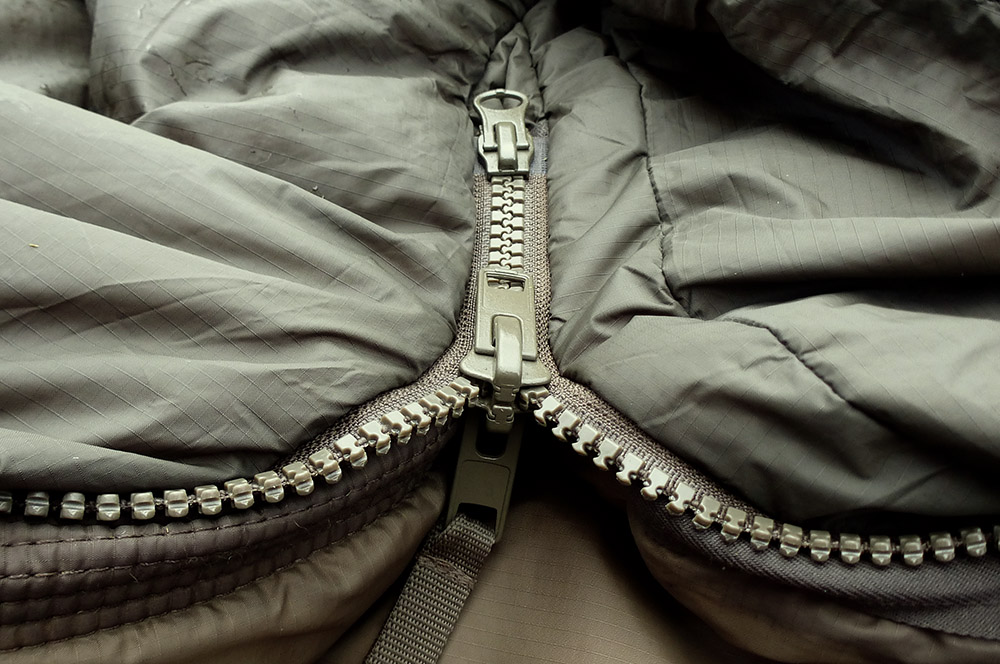 The award for "best zips on a sleeping bag" goes to .... Carinthia for their Defence 4.
The award for "best zips on a sleeping bag" goes to .... Carinthia for their Defence 4.
This zip area is dually protected: firstly, on the under-side, by a large, thick baffle which prevents warmth escaping from inside the sleeping bag.
 The Carinthia Defence 4's super thick zip baffle
The Carinthia Defence 4's super thick zip baffle
And secondly by a velcro storm flap which covers the full length of the zip.
 Defence 4's storm flap covers the central zip.
Defence 4's storm flap covers the central zip.
The Footbox
The footbox is larger than in many traditional mummy bags, partly because military personnel sometimes have to sleep in their boots, but also because the Defence 4 is designed to host a lighter bag inside it. The trapezoidal design prevents the feet from compressing the insulation, creating cold spots. It also provides room to store a shoe/boot bag or spare clothing.
The footbox has two strong hanging loops for drying out the bag. There are also 6 similar loops on the inside of the bag, and due to the way it's constructed (outlined above), the bag dries quite quickly.
 A roomy, trapezoidal footbox with hanging loops.
A roomy, trapezoidal footbox with hanging loops.
Temperature Rating
The EN 13537 European Standard temperature ratings break down as follows:
- Comfort temperature: A "standard woman" with relaxed posture is close to feeling cold but is "not feeling cold".
- Comfort Limit temperature: A "standard man" with curled up posture is close to feeling cold but is "not feeling cold".
- Extreme temperature: This is where a "standard woman" risks harm (health complications / damage) from hypothermia.
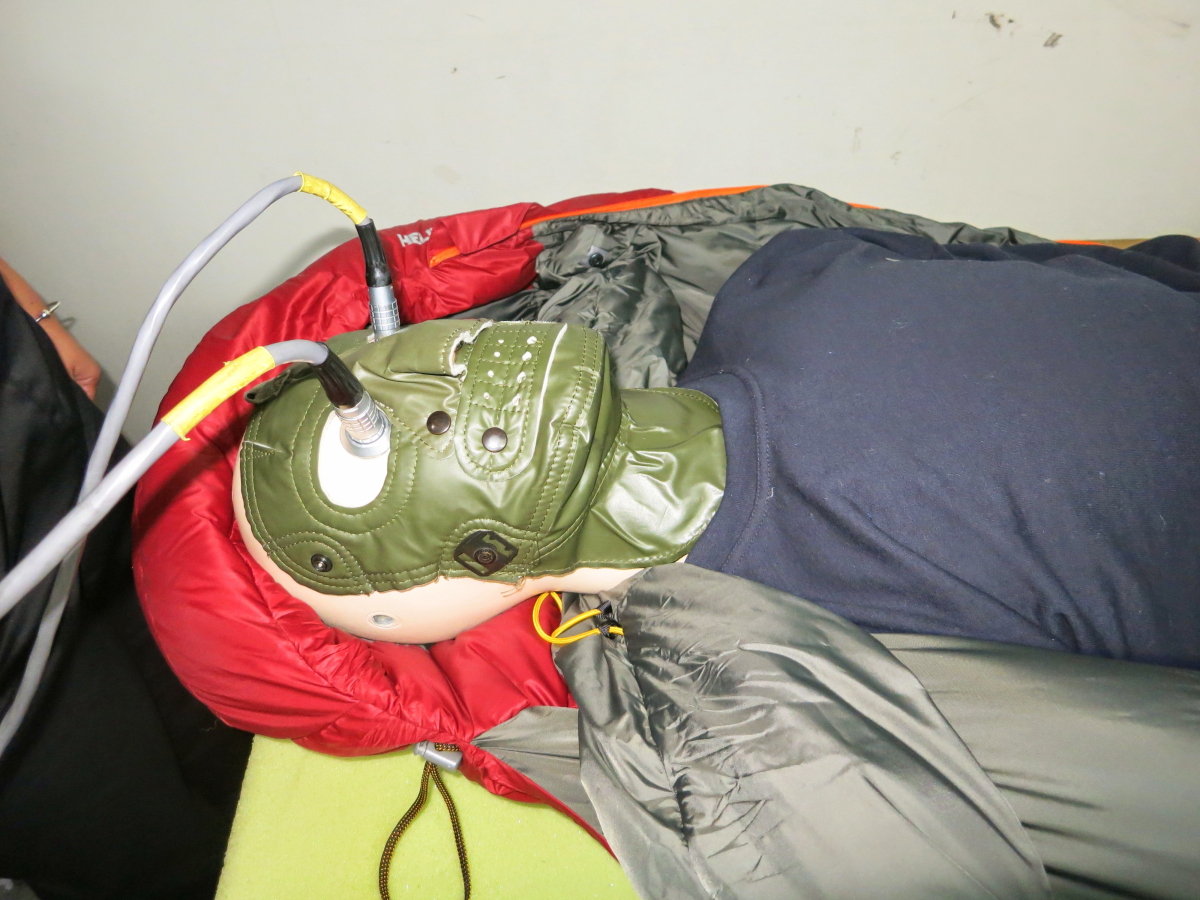 A temperature rating test manikin (Copyright Matthew Fuller, UKC)
A temperature rating test manikin (Copyright Matthew Fuller, UKC)
If you sit naked in the snow for 5 minutes, the first time it will be painful, the next time less so, the time after that you'll be able to extend the duration etc. The body has innate bio-chemical processes which kick in and enable us to adapt to conditions, which is why we've been so "successful" as a species. Central heating and a desire for comfort and convenience may have dimmed these innate adaptive abilities, but they're still there. Energy metabolism, diet, fat stores, tiredness, conditioning, all these factors affect how warm an individual feels in a sleeping bag. So these temperature ratings are merely a guide, a useful best guess, and should not be viewed as anything more than that.
For men, the Comfort Limit is the guide of most interest. The Carinthia Defence 4 is (EN 13537) rated down to -15°C.
Sub-Zero Sleeping Bags: Not just for humans
The Defence 4 is a very warm sleeping bag. Yet if one were to believe the dogma out there, it shouldn't be. It has no neck baffle, it's relatively broad at the shoulders, and it isn't body-huggingly mummy-shaped. So, in theory that is supposed to mean a large volume of redundant air that needs to be warmed up. There's a number of things wrong with this picture:
- It assumes that only you will inhabit the sleeping bag. In practice, in cold temperatures there's a whole load of stuff you might want to pack inside your sleeping bag: damp clothing (that you want to get dry), your boots, a bottle of water (i.e. stuff you don't want frozen solid), batteries for your devices (so they don't die), dry clothing that you want warm in the morning, etc ...
- It ignores what we do naturally in our sleep or as we fall asleep. If there is additional space we tend to pull it in and/or wrap it up tight around us. Think about lying under a duvet in a cold room, you pull the duvet snug around you, this compresses the space, leaving less air to warm. The exact same thing happens in my experience with a sleeping bag. If you're cold, you pull in any slack and curl into a fetal position on your side and keep warm.
The main justification for a tight fitting sleeping bag is that it's not as big, and thus should weigh less and pack down smaller. The disadvantage is that you can't store anything but you inside it, and when you reach its limit, there's no room for additional fortification. So, now you need a new, warmer sleeping bag ... and maybe that's the point.
Weight in context
The Defence 4 (185) version (without stuff sack, see below) weighs in at 1,650g. To put this into perspective Mountain Equipment's Aurora III (pictured right) has a max user height of 6ft (matching the Defence 4 185). It weighs 1,695g, has a comfort limit of -12°C/10°F and an Extreme of -31°C/-24°F. So by spec, the Carinthia Defence 4 (185) is a similar weight, 3°C warmer and costs around £80 less. Not bad for a "heavy duty" military bag that is larger and can accommodate more than just its owner. Unlike the Aurora III, the Defence 4 was designed to accommodate quite a bit more ...
Modularity: A flexible system
The Defence 4 was designed as a modular sleeping bag. Some time ago, the U.S. and NATO forces realised that modularity was the way to go*, no longer did they provide an Extreme Cold Weather ("arctic") option, instead they provided a 3 season bag that could host a lighter 2 season (patrol) bag inside it. Doubling up, extended the range of the 3 season bag down into extreme sub zero temperatures. This explains the relaxed mummy-shape of the bag, which is important when hosting a lighter bag inside, as you don't want the outer to overly compress the inner bag's insulation; this would reduce its warmth and thus defeat its purpose (this is precisely what would happen to additional insulation inside a bag like the well regarded Aurora III).
According to the site Olive-Drab, the Extreme Cold Weather (ECW) Sleep System was replaced with the modern day Modular Sleep System (MSS) in the early 2000's. Carinthia supply a number of European armies (such as the Bundeswehr, the Finnish and other Scandinavian Defence Forces) with their NATO approved version (Defence 4 + Tropen) of the MSS. What is noticeable about Carinthia, aside from the very high quality of their manufacturing, is the relatively light weight of their bags. For example, the UK MOD (being cheapskates) use a Spanish contractor, FECSA (Fabrica Española de Confecciones, S.A.) to make their version of the Defence 4. Performance wise, they're not far behind, but weight wise there's a big difference. The FECSA (185) version weighs 380g more than the Defence 4 (185).
* The situation is reminiscent of the MOLLE system, where the military embrace flexibility and efficiency because it's sensible and expedient to do so. One has to wonder why the outdoor industry aren't doing the same? (With my cynical hat on, I can hazard a guess).
In Context: Scramble's Recommended Sleeping Bag System
The military modular system uses 2 bags: a lighter "patrol" bag (down to 0°C) and a medium-weight cold weather bag (down to -15°C) which combine for extreme cold (down to -30°C, but a total weight of nearly 3kg). Scramble's recommended "modular" system uses 3 bags, is lighter and more flexible (better in hotter, arid conditions, yet still good down to -20°C and likely -25°C, the extreme combination weighing just over 2kg).
Measured weights (without stuff sacks, see our note below*):
- Warm + Dry Weather: Alpkit Cloud Cover = 438g (stuff sack +14g)
- Warm + Wet Weather: Carinthia G-90 (L) = 694g (stuff sack +64g)
- Spring + Autumn: Cloud Cover + Carinthia G-90 (L) = 1,132g
- Winter: Carinthia Defence 4 (M) = 1,650g (stuff sack +209g)
- Extreme Cold: Defence 4 (M) + Cloud Cover = 2,088g (stuff sack = Osprey Ultralight Pack Liner, Small, 30 - 50L = 78g).
Any Negatives?
I had initial reservations regarding the Defence 4's hood and lack of neck baffle, however, in use, both have been dispelled. Some people may find the small face-hole is something they cannot get used to and so this bag may not be for them. Others, who don't spend prolonged periods outdoors in wet and cold conditions, and never store anything in their sleeping bag but them, and who know they will not encounter temperatures that push the Comfort Limit of their bag, may prefer a bag like ME's Aurora III pictured above or a down option. But for Scramble's purposes, the Defence 4 is almost ideal.
One negative is symptomatic of a positive, namely the Defence 4's wind and water resistance, which results in the bag being so effective at trapping air between the outer shell and the quilted insulation, that when it comes time to pack, it can be more of a fuss to stuff than other sleeping bags.
Carinthia provide a heavy duty stuff sack (weighing around 200g) with the Defence 4 and this compresses the bag quite well. But there are other sleeping bags that compress smaller. The Carinthia will take up a reasonable amount of space in ones pack. When your hands are cold and conditions are miserable, you don't pack up as well as you do in your home. The Defence 4 fits nicely into an Osprey Ultralight Pack Liner (S, 30 - 50L) and when sat on the remove as much trapped air as possible you can pretty much vacuum pack it and fit then mould it to the base of your pack. This mitigates these minor negatives to some degree, but we've deducted 1 point in total for function.
Conclusion & Rating
An extremely warm bag, exceptional in extended wet conditions, extremely robust and largely weather-proof, yet competitively light and surprisingly breathable. The Carinthia Defence 4, designed as a modular (host) sleeping bag, offers the user superb protection on its own (down to -15°C), and makes an almost bivi-like* protective outer for any lightweight down inner / liner sleeping bag options. When combined with Alpkit's Cloud Cover (hybrid down quilt and sleeping bag), the Defence 4 can extend its Comfort Limit reach down to -20°C, possibly to -25°C (though untested). Having used this bag now for many years, reservations that were present in early use quickly disappeared. On the surface its design seems lacking in technical sophistication, but in use one soon discovers that its sophistication lies in the choice and combination of materials used, their fabrication (and design in terms of how they're put together), its minimal points of failure and its robust and highly functional features.
A while back, military sleeping bags were tough but too heavy for weight conscious trekkers to seriously consider. The military got wise, lost some weight and went modular. No doubt using expertise gained in the development of their consumer range, in the Defence 4, Carinthia have created a synthetic bag that can compete with the top outdoor brands on weight, yet wins big when it comes to durability, robustness and weather protection.
An outstanding sleeping bag, and Scramble's top pick as our modular cold weather option (in the "4 Season Sub Zero Sleeping Bag and Extreme Outer" category).
* We don't recommend using this bag without some form of over-head shelter, as although it's practically waterproof, prolonged precipitation will overwhelm it.
Product Images
Rating (out of 10)
* The value score is derived from two factors:
1) Competitive Market Price (CMP). This represents our judgement of a competitive online price point if we were to stock the item. e.g. if we feel we would need to sell an item at 40% off (i.e. 60% of its full RRP) to be competitive, then our CMP score will be 6/10.
2) Customer Value Price (CVP). We then make an honest appraisal of the maximum price we would be willing to pay for the item (and we're mean). So if we'd pay 80% of its RRP our CVP score would be 8/10.
We then average the two scores to get our final value score, which in our example would be 7/10.
Postscript
Why not down all the way?
As an inner bag, down is superb. If you can guarantee arid conditions (deserts, Himalayas, arctic etc.) then down is the way to go, but for the UK and northern Europe, not so much and you literally have to factor in a daily thermal performance loss for down in wet conditions (regardless of hydrophobic patches to an insoluble problem).
Andy Kirkpatrick explains:
"There is nothing as great as a bone dry down sleeping bag. Unfortunately there is also nothing as grim as a wet one. Saturated down loses 90% of its insulation as the delicate structure of the clusters stick together and collapse. The down absorbs a lot of water and because it loses most of its thermal performance it must be dried via an outside heat source like the sun, a tumble dryer or a body. In many cases where there is moisture present, a down bag will lose performance each night it is used, as the down becomes slowly saturated. The rate at which this happens is dependent on the skill of the user and the conditions in which it is being used. This water contamination comes both from without and within the bag and learning to slow the speed of this performance drop is one of the skills needed to use a down bag effectively. Down just doesn’t work in high saturated environments and best suits cold and dry conditions, or the protected sanctuary of a dry space like a tent, hut or snow hole."
Our Winter Kit test in 2016 was particularly tricky and saw 4 days of permanent heavy rain, hail and sleet book-ended by 3 days of freezing cold (down to -8°C). Everything got wet (regardless of care and skill) and the Defence 4, being synthetic held up superbly, a down bag would have been a disaster and quite possibly dangerous.
* A note on stuff sacks and weight stats
We don't quote the weights including stuff sacks, mainly because we don't feel the manufacturer's choice of stuff sack design has a great deal to do with their sleeping bags (an example is Mountain Hardwear's Lamina bags which come with something more akin to a Tesco's 10 gram shopping bag, whereas Carinthia's come with military grade compression sacks; apples and oranges and all that. In addition we only use a stuff sack for the sub-zero bag, and for that we use an Osprey Ultralight Pack Liner (S, 30 - 50L) The G-90 can simply go in the base of ones pack (assuming it has a waterproof liner) as it fills the nooks and crannies well and gets compressed by all your other kit. The Cloud Cover comes with a superlight sack and likewise easily gets compressed when you cover it with the rest of your stuff. If it's used as an inner, then it can just go inside the G-90 or the Defence 4.
Last Updated: 11/04/22


